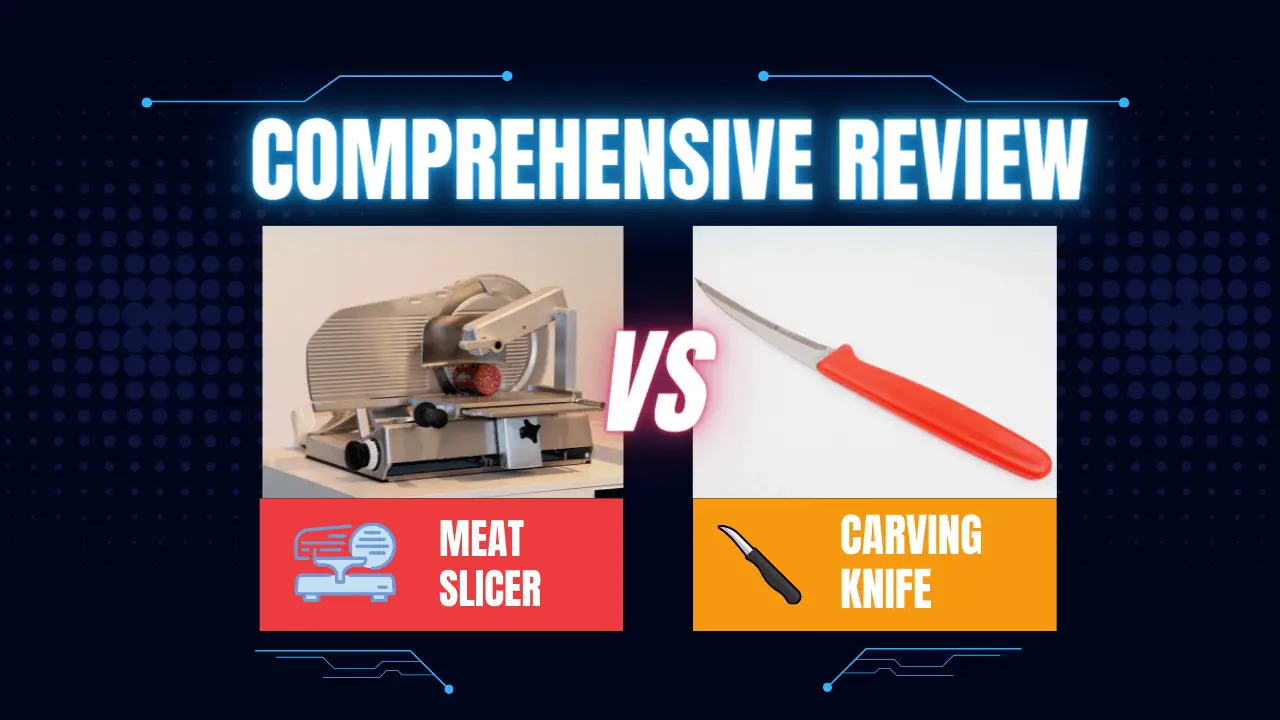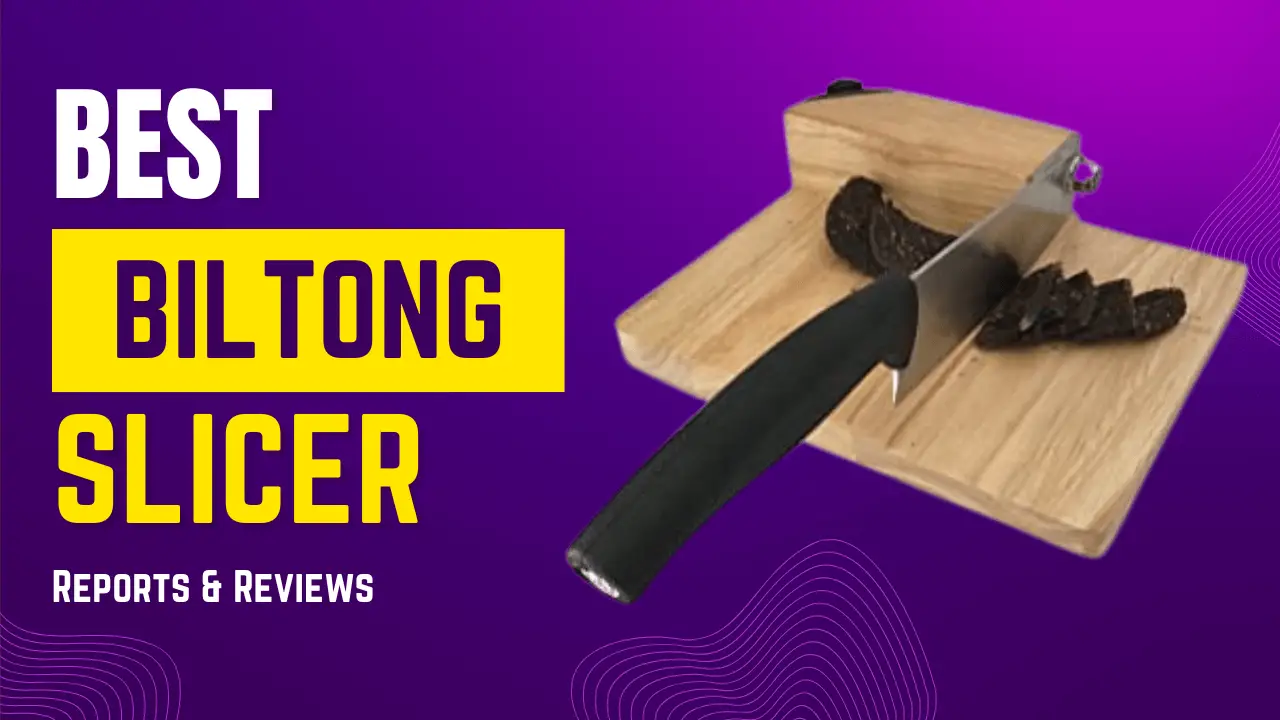The Sashimi Knife is a versatile tool with a long, narrow, and thick blade, suitable for slicing raw fish, sushi rolls, and delicate ingredients. On the other hand, the Sashimi Slicer is a specialized tool with a double-edged blade designed specifically for sashimi and sushi preparation, offering enhanced precision. Both options have advantages, so choose the tool that best fits your needs and culinary preferences.
Sashimi Knife: Mastering the Art of Precision Slicing
The Anatomy of a Sashimi Knife
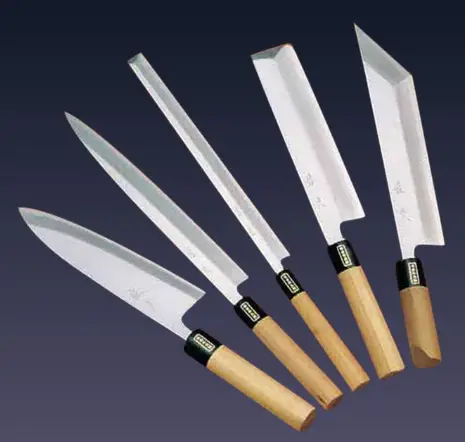
A sashimi knife is a specialized Japanese knife designed for the precise art of slicing delicate ingredients, particularly raw fish and sushi rolls.
Key Features and Benefits
Long, narrow, and thick blade for effortless separation of cuts:
The sashimi knife typically boasts a long, narrow blade, usually around 10 inches long. This elongated blade allows for clean and seamless cuts through various ingredients, maintaining the integrity of the delicate structure.
Right-sided bevel for clean slicing and separation of food:
The sashimi knife features a special right-sided angle, which aids in separating slices without any effort or the risk of pieces sticking back together. This bevel enhances the precision and cleanliness of each cut.
A versatile tool for cutting raw fish, sushi rolls, and other delicate ingredients:
While the sashimi knife is commonly associated with slicing raw fish for sashimi and sushi, it offers much more versatility. This knife can be used for cutting other delicate ingredients like vegetables, fruits, or even thin slices of meat, making it a versatile tool for various culinary creations.
High-quality stainless steel blade for long-lasting sharpness:
The blade of a sashimi knife is crafted from high-quality stainless steel, ensuring exceptional sharpness and durability. This material retains its sharp edge for extended periods, minimizing the need for frequent sharpening and ensuring consistent slicing performance.
Natural wooden handle for a comfortable and ergonomic grip:
The handle of a sashimi knife is typically made of light brown wood, which adds an elegant touch and offers a comfortable grip. The slightly oval shape of the handle fits naturally in the hand, allowing for extended slicing tasks without causing fatigue.
Applications of a Sashimi Knife
A sashimi knife is a versatile tool beyond its association with slicing raw fish for sushi and sashimi.
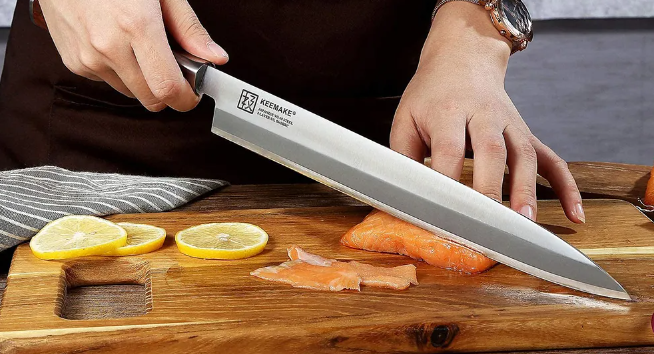
Perfect for slicing raw fish for sushi and sashimi:
The primary application of a sashimi knife is to effortlessly slice raw fish into thin, uniform pieces for sushi and sashimi dishes. Its long, narrow blade allows for precise cuts that maintain the delicate texture and appearance of the fish. Whether you’re preparing nigiri, sashimi platters, or sushi rolls, a sashimi knife is essential for achieving professional-quality results.
Ideal for creating thin, delicate cuts of other soft and delicate ingredients:
Apart from raw fish, a sashimi knife is also excellent for creating thin, delicate slices of other soft ingredients. Whether you’re working with tender cuts of meat, thinly sliced vegetables for garnishing, or even delicate fruits, the sashimi knife’s sharp blade and precision cutting capabilities ensure consistent, even slices.
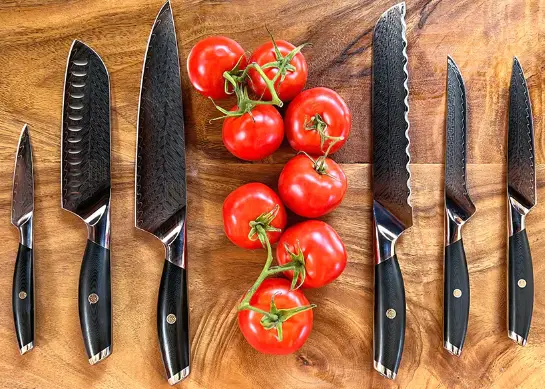
Useful for various kitchen tasks that require precision slicing:
The versatility of a sashimi knife extends to a wide range of kitchen tasks that demand precision slicing. From carving roast meats to cutting through cake layers for perfect portions, this knife delivers clean and precise cuts. It can also be used to fillet small-sized fish or debone poultry, showcasing its adaptability beyond raw fish preparation.
Sashimi Slicer: Fine-Tuned Precision for Culinary Perfection
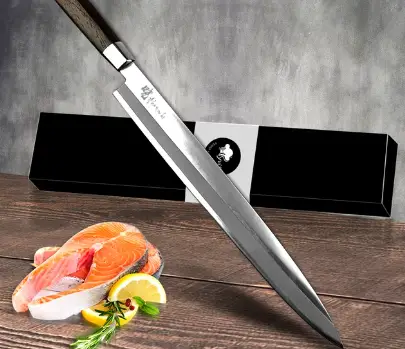
Understanding the Sashimi Slicer
A sashimi slicer is a specialized tool to prepare sashimi, sushi, and sliced raw fish.
Key Features and Benefits
Double-edged blade with one side angled and the other flat:
The sashimi slicer features a double-edged blade, with one side angled and the other flat. This design allows for sharper and more precise cutting and slicing capabilities. The angled side enables effortless slicing through ingredients, while the flat side ensures clean separation of each slice.
Designed specifically for preparing sashimi, sushi, and sliced raw fish:
The sashimi slicer is crafted to prepare sashimi, sushi, and sliced raw fish in mind. Its construction and blade geometry are optimized to achieve the finest cuts of raw fish and seafood, ensuring the precision and reach slice’s utmost precision and artistry.
The Artistry of Kosuke Muneishi Hand-Forged Sashimi Slicer
The Kosuke Muneishi Hand-Forged Sashimi Slicer represents the epitome of craftsmanship and attention to detail.
Handcrafted in Tosa, Kochi prefecture, Japan, with traditional techniques:
The Kosuke Muneishi Hand-Forged Sashimi Slicer is meticulously crafted in Tosa, Kochi prefecture, Japan, using traditional techniques passed down through generations. The knife-making process involves the skilled hands of craftsmen who meticulously forge, shape and refine the blade to perfection.
Produced by Mr. Kosuke Muneishi, the third-generation head of Muneishi Knife:
This sashimi slicer is the result of the expertise and dedication of Mr. Kosuke Muneishi, the third-generation head of Muneishi Knife. With years of experience and a deep understanding of the art of knife-making, Mr. Muneishi ensures that each sashimi slicer meets the highest standards of quality and precision.
Attention to Kurouchi finish for a distinctive appearance and enhanced iron characteristics:
The Kosuke Muneishi Hand Forged Sashimi Slicer features a Kurouchi finish. This traditional blackened finish not only enhances its distinctive appearance but also improves the iron characteristics of the blade. This finish adds a touch of artistry and authenticity to the knife.
Utilizes high-quality blue two-steel for superior hardness (HRC 64-65):
The Kosuke Muneishi Hand Forged Sashimi Slicer blade is crafted from high-quality blue two-steel, renowned for its exceptional hardness (HRC 64-65). This steel ensures superior edge retention and durability, allowing the slicer to maintain its sharpness over time.
Advantages and Use Cases
A sashimi slicer offers distinct advantages and serves various use cases for those seeking precision slicing and cutting.
A Versatile tool that serves as a regular Sujihiki knife and Yanagiba Sashimi knife:
One of the key advantages of a sashimi slicer is its versatility. It can function as a regular Sujihiki knife and a Yanagiba Sashimi knife. As a Sujihiki knife, it excels in slicing and portioning various ingredients, while as a Yanagiba Sashimi knife, it is specifically designed for precise cuts of raw fish and seafood. This versatility allows users to tackle a wider range of slicing tasks with a single tool.
Ideal for precision slicing and cutting raw fish and seafood:
The sashimi slicer’s specialized design and sharp blade make it an ideal choice for achieving precision slices of raw fish and seafood. Its exceptional cutting performance ensures clean and consistent cuts, enhancing the overall presentation and texture of the dish. Whether you’re preparing sashimi platters, sushi rolls, or delicate seafood garnishes, the sashimi slicer is a valuable tool for achieving culinary perfection.
Suitable for professional chefs and sushi enthusiasts seeking exceptional craftsmanship:
The sashimi slicer, particularly high-quality options like the Kosuke Muneishi Hand Forged Sashimi Slicer, appeals to professional chefs and sushi enthusiasts who value exceptional craftsmanship. These individuals appreciate the artistry and precision of creating a finely crafted sashimi slicer. With its superior construction, attention to detail, and high-quality materials, the sashimi slicer exemplifies the pursuit of culinary excellence.
Which Tool is Right for You?
Choosing the Perfect Tool
Consider the following factors when deciding between a Sashimi Knife and a Sashimi Slicer:
Skill level:
Sashimi Knife is versatile and user-friendly, while the Sashimi Slicer requires more skill.
Desired thickness:
Sashimi Knife allows for adjusting the thickness with your technique, while the Slicer offers consistent precision.
Frequency of use:
Sashimi Knife is an all-purpose tool, while the Slicer specializes in sashimi and sushi.
Budget:
Sashimi Knife is more affordable, while the Slicer may be a higher investment.
FAQs (Frequently Asked Questions)
Can I use a Sashimi Knife for purposes other than slicing raw fish?
Yes, definitely! A Sashimi Knife is a versatile tool that can be used for various delicate ingredients and precision slicing tasks.
What is the advantage of a Sashimi Slicer over a regular knife?
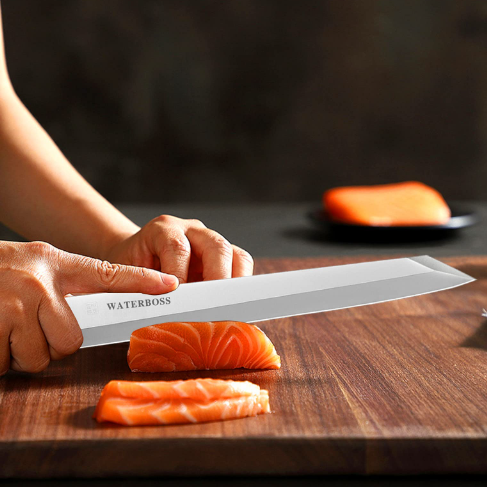
The Sashimi Slicer is designed specifically for sashimi and sushi preparation, offering enhanced precision and sharper cutting capabilities.
How should I care for my Sashimi Knife or Slicer?
It’s essential to hand wash and dry the blade immediately after use and store it safely to maintain its sharpness and longevity.
Conclusion:
The Sashimi Knife and the Sashimi Slicer have unique advantages and applications. The Sashimi Knife offers versatility and ease of use for various slicing tasks, while the Sashimi Slicer excels in the precision slicing of raw fish and seafood. Choose the tool that aligns with your needs, skill level, and culinary preferences to enhance your slicing techniques and create stunning dishes with finesse.
Key Points:
- Sashimi knives are versatile tools for slicing delicate ingredients, including raw fish.
- Sashimi slicers are specialized knives for sashimi, sushi, and thinly sliced raw fish.
- Sashimi knives offer versatility and convenience, while sashimi slicers excel in precision slicing.
- Consider factors such as purpose, cutting technique, skill level, and design preferences when choosing between the two.
- Both tools require proper care and maintenance for optimal performance and longevity.
Pros And Cons, Similarities And Differences:
Here’s a 5-column table comparing the pros, cons, similarities, and differences between a Sashimi Knife and a Sashimi Slicer:
| Sashimi Knife | Sashimi Slicer | |
|---|---|---|
| Pros | – Versatile applications for various slicing tasks | – Specialized for sashimi, sushi, and raw fish |
| – Can be used for general slicing and cutting | – Creates thin, precise slices with pulling motion | |
| – Suitable for beginners and experienced cooks | – Blends tradition with modern design and materials | |
| Cons | – Requires two-handed grip and slicing motion | – Requires practice and skill for the unique technique |
| – May not achieve the same precision as a slicer | – Limited to specific slicing tasks | |
| Similarities | – Can slice delicate ingredients like raw fish | – Used for creating sashimi and sushi |
| – Require proper care and maintenance | – Enhance culinary precision and presentation | |
| – Can be found in left-handed and right-handed | – Enhance the overall dining experience | |
| Differences | – Versatile, all-purpose knife | – Specialized, focused on sashimi and sushi |
| – Blade designed for general slicing tasks | – Angled blade for precise slicing from one side | |
| – Reflects traditional Japanese design and quality | – Blends traditional forging with modern materials |
References And Citations:
Here are some suggested external links with corresponding anchor text for the above article:
- Lucky Cook Sashimi Knife –https://www.amazon.com/stores/LuckyCook/LuckyCook/page/4584F4A1-44D5-43D5-BCFE-F19E24AD0ED3 “Lucky Cook 10-inch sashimi knife”
- Kosuke Muneishi Sashimi Slicer – https://ibukiblade.com/products/kosuke-muneishi-hand-forged-blank-blade-blue-2-steel-sashimi-knife“Kosuke Muneishi Hand forged Sashimi Slicer”
- Japanese Knife-Making Techniques –https://www.seriouseats.com/japanese-knife-village “traditional Japanese knife-making.”
- Caring for Your Sashimi Knife – https://www.nativeandco.com/journal/daily-care-for-japanese-steel-knives“Proper care and maintenance”
- Beginner’s Guide to Sushi Making –https://www.denverpost.com/2012/06/25/sushi-for-beginners-five-steps-to-making-sushi-at-home/ “Sushi, sashimi, and raw fish.”

John Hebdon is a food enthusiast, passionate chef, and author of various articles and blog posts related to food and cooking. With a deep love for all things culinary, John’s blog serves as a platform to share his extensive kitchen experiences with a broader audience.
In addition to his culinary expertise, John has a flair for writing and a natural ability to share his passion for food with others. His articles and blog posts are informative, engaging, and packed with practical tips for readers of all skill levels.
As a food enthusiast and writer, John is always on the lookout for new and exciting culinary experiences. Whether it’s trying out a new restaurant, experimenting with a new recipe, or simply sharing a favorite dish with friends and family, John is always eager to explore and share the world of food with others.


